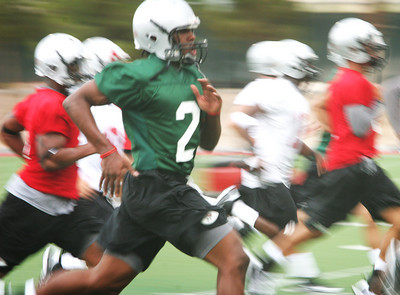Clayton gets QB nod; Dixon to ‘D’

Omar Clayton is UNLV’s starting quarterback.
That’s not the surprise.
The who-saw-that-coming news was the Rebels’ decision to move Clayton’s competition at that position, Travis Dixon, to safety.
Dixon himself announced the move at a team meeting Monday, the first day of preseason practice. The position change speaks highly of the coaches’ opinion of Dixon’s athleticism, but also magnifies concerns about the need to bolster the safety position.
Coach Mike Sanford said he didn’t know where Dixon, a 6-foot-1-inch 195-pound sophomore, would fit on the depth chart. Juniors Daryl Forte (5-10, 200) and Terrance Lee (6-0, 175) are the probable starters at safety, but there is a lack of depth. Shane Horton, who started four games last year, transferred to Southern California.
Dixon was UNLV’s starting quarterback for the first seven games and final two last season, with Clayton starting the other three before breaking his right hand.
By switching to safety, Dixon will stand a better chance of helping the Rebels. Sanford made the same position switch — quarterback to safety — while playing for USC during the 1970s.
“We want to get our best players on the field,” Sanford said of Dixon. “I think Travis at safety gives us an opportunity to get a really good player that our team trusts, believes in, playing a position that we have a need in.”
Dixon’s debut at safety went well as he made an interception during practice Monday.
No matter how badly he is needed at safety, however, moving from football’s glamour position is not easy. Dixon said he never considered transferring, and Clayton said his former competitor “took it like a champ.”
“I’m a team player, so I’m here to help UNLV win,” Dixon said. “We’ve had too many 2-9, 2-10 seasons around here. I came here to win. If this is what I’ve go to do to be a part of a winning program, I’m all with that.”
Dixon said he can’t wait to get into full pads and begin full-contact drills.
“I’m going to try to take somebody’s head off, let them know I’m not soft even though I played quarterback,” Dixon said, smiling. “I’m out here to let somebody know I’m out on the field, and I’m not just a prima donna at quarterback.”
Clayton said he looks forward to testing Dixon’s safety skills.
“I’m hoping I can pick on him and try to make him look bad a couple of times,” Clayton said, also chuckling.
Clayton had been favored to be the starting quarterback, an eventuality that seemed certain after Sanford said July 21 that a decision would come in the first week of practice.
In addition to overtaking Dixon as the starter last season, Clayton (6-1, 200) put together a strong spring game, completing 9 of 11 passes for 108 yards and two touchdowns.
He followed that by looking sharp during offseason workouts. NCAA rules prohibit coaches from attending or evaluating players during that time.
“Our players were (evaluating), though,” Sanford said. “We wouldn’t have a big quiz or anything, but we would run into them, and we would hear how those workouts were going. As things went on, there were a lot of good things being said about Omar and a lot of good things being said about (new No. 2) Mike Clausen.”
Clayton walked on last season and was listed No. 5 on the depth chart. After the Rebels went 2-5 in Dixon’s first seven starts, Clayton was given the nod against Colorado State.
He showed his inexperience while committing four first-half turnovers, but only one in the second half. Clayton also became the first UNLV quarterback to pass for at least 300 yards and rush for at least 100 in the same game.
In his third start, Clayton broke his right hand and was done for the year. Dixon finished up as the starter.
Though young, Clayton showed enough promise in the Rebels’ 2-10 season to give coaches hope.
UNLV opens this season Aug. 30 against Utah State at Sam Boyd Stadium. This year, Clayton has time to prepare.
“We can work even more with (Clayton) now these next two weeks,” wide receiver Casey Flair said. “Plus, we have Mike Clausen who will get a lot more (repetitions) now and will come in and start throwing the ball to a lot of us. So it’s good for our offense as far as timing goes.”